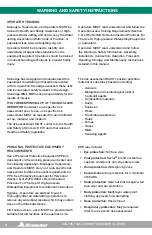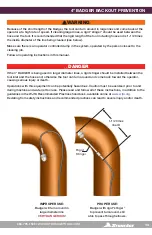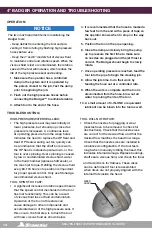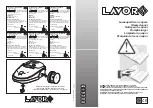
866-795-1586 • WWW.STONEAGETOOLS.COM
4
PERSONAL PROTECTIVE EQUIPMENT
REQUIREMENTS
Use of Personal Protective Equipment (PPE) is
dependent on the working pressure of water and
the cleaning application. Managers, Supervisors,
and Operators MUST carry out a job specific risk
assessment to define the exact requirements for
PPE. See Protective Equipment for Personnel
(Section 6) of WJTA-IMCA’s Recommended
Practices For The Use Of High-pressure
Waterjetting Equipment for additional information.
Hygiene - Operators are advised to wash
thoroughly after all waterjetting operations to
remove any waterblast residue which may contain
traces of harmful substances.
First aid provision - users MUST be provided with
suitable first aid facilities at the operation site.
PPE may include:
• Eye protection:
Full face visor
• Foot protection:
Kevlar® brand or steel toe
capped, waterproof, non-slip safety boots
• Hand protection:
Waterproof gloves
• Ear protection:
Ear protection for a minimum
of 85 dBA
• Head protection:
Hard hat that accepts a full
face visor and ear protection
• Body protection:
Multi-layer waterproof
clothing approved for waterjetting
• Hose protection:
Hose shroud
• Respiratory protection:
May be required;
refer to job specific risk assessment
StoneAge has designed and manufactured this
equipment considering all hazards associated
with its operation. StoneAge assessed these risks
and incorporated safety features in the design.
StoneAge
WILL NOT
accept responsibility for the
results of misuse.
IT IS THE RESPO
NSIBILITY OF THE INSTALLER/
OPERATOR
to conduct a job specific risk
assessment prior to use. Job specific risk
assessment MUST be repeated for each different
set up, material, and location.
The risk assessment MUST conform to the Health
and Safety at Work Act 1974 and other relevant
Health and Safety legislation.
The risk assessment MUST consider potential
material or substance hazards including:
•
Aerosols
•
Biological and microbiological (viral or
bacterial) agents
•
Combustible materials
•
Dusts
•
Explosion
•
Fibers
•
Flammable substances
•
Fluids
•
Fumes
•
Gases
•
Mists
•
Oxidizing Agents
OPERATOR TRAINING
Managers, Supervisors, and Operators MUST be
trained in Health and Safety Awareness of High-
pressure Water Jetting and hold a copy the Water
Jetting Association (WJA) Code of Practice, or
equivalent (see www.waterjetting.org.uk).
Operators MUST be trained to identify and
understand all applicable standards for the
equipment supplied. Operators should be trained
in manual handling techniques to prevent bodily
injury.
Operators MUST read, understand, and follow the
Operational and Training Requirements (Section
7.0) of WJTA-IMCA’s Recommended Practices For
The Use Of High-pressure Waterjetting Equipment,
or equivalent.
Operators MUST read, understand and follow
the Warnings, Safety Information, Assembly,
Installation, Connection, Operation, Transport,
Handling, Storage, and Maintenance Instructions
detailed in this manual.
WARNING AND SAFETY INSTRUCTIONS





































